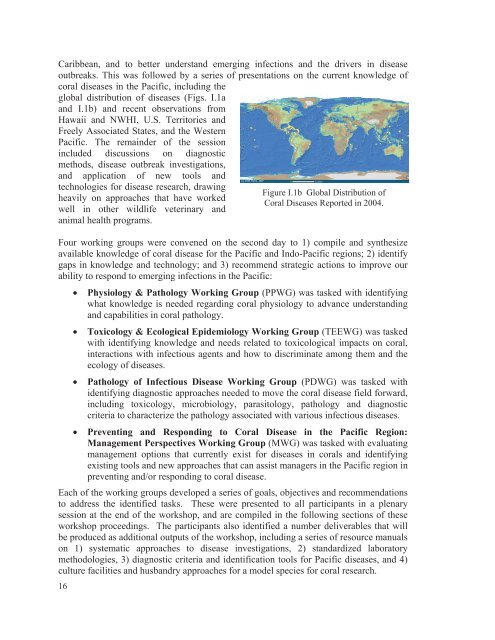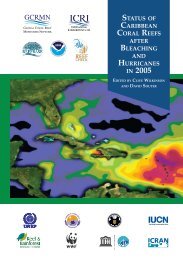Coral Health and Disease in the Pacific: Vision for Action
Coral Health and Disease in the Pacific: Vision for Action
Coral Health and Disease in the Pacific: Vision for Action
Create successful ePaper yourself
Turn your PDF publications into a flip-book with our unique Google optimized e-Paper software.
Caribbean, <strong>and</strong> to better underst<strong>and</strong> emerg<strong>in</strong>g <strong>in</strong>fections <strong>and</strong> <strong>the</strong> drivers <strong>in</strong> diseaseoutbreaks. This was followed by a series of presentations on <strong>the</strong> current knowledge ofcoral diseases <strong>in</strong> <strong>the</strong> <strong>Pacific</strong>, <strong>in</strong>clud<strong>in</strong>g <strong>the</strong>global distribution of diseases (Figs. I.1a<strong>and</strong> I.1b) <strong>and</strong> recent observations fromHawaii <strong>and</strong> NWHI, U.S. Territories <strong>and</strong>Freely Associated States, <strong>and</strong> <strong>the</strong> Western<strong>Pacific</strong>. The rema<strong>in</strong>der of <strong>the</strong> session<strong>in</strong>cluded discussions on diagnosticmethods, disease outbreak <strong>in</strong>vestigations,<strong>and</strong> application of new tools <strong>and</strong>technologies <strong>for</strong> disease research, draw<strong>in</strong>gheavily on approaches that have workedwell <strong>in</strong> o<strong>the</strong>r wildlife veter<strong>in</strong>ary <strong>and</strong>animal health programs.Four work<strong>in</strong>g groups were convened on <strong>the</strong> second day to 1) compile <strong>and</strong> syn<strong>the</strong>sizeavailable knowledge of coral disease <strong>for</strong> <strong>the</strong> <strong>Pacific</strong> <strong>and</strong> Indo-<strong>Pacific</strong> regions; 2) identifygaps <strong>in</strong> knowledge <strong>and</strong> technology; <strong>and</strong> 3) recommend strategic actions to improve ourability to respond to emerg<strong>in</strong>g <strong>in</strong>fections <strong>in</strong> <strong>the</strong> <strong>Pacific</strong>:16Figure I.1b Global Distribution of<strong>Coral</strong> <strong>Disease</strong>s Reported <strong>in</strong> 2004.Physiology & Pathology Work<strong>in</strong>g Group (PPWG) was tasked with identify<strong>in</strong>gwhat knowledge is needed regard<strong>in</strong>g coral physiology to advance underst<strong>and</strong><strong>in</strong>g<strong>and</strong> capabilities <strong>in</strong> coral pathology.Toxicology & Ecological Epidemiology Work<strong>in</strong>g Group (TEEWG) was taskedwith identify<strong>in</strong>g knowledge <strong>and</strong> needs related to toxicological impacts on coral,<strong>in</strong>teractions with <strong>in</strong>fectious agents <strong>and</strong> how to discrim<strong>in</strong>ate among <strong>the</strong>m <strong>and</strong> <strong>the</strong>ecology of diseases.Pathology of Infectious <strong>Disease</strong> Work<strong>in</strong>g Group (PDWG) was tasked withidentify<strong>in</strong>g diagnostic approaches needed to move <strong>the</strong> coral disease field <strong>for</strong>ward,<strong>in</strong>clud<strong>in</strong>g toxicology, microbiology, parasitology, pathology <strong>and</strong> diagnosticcriteria to characterize <strong>the</strong> pathology associated with various <strong>in</strong>fectious diseases. Prevent<strong>in</strong>g <strong>and</strong> Respond<strong>in</strong>g to <strong>Coral</strong> <strong>Disease</strong> <strong>in</strong> <strong>the</strong> <strong>Pacific</strong> Region:Management Perspectives Work<strong>in</strong>g Group (MWG) was tasked with evaluat<strong>in</strong>gmanagement options that currently exist <strong>for</strong> diseases <strong>in</strong> corals <strong>and</strong> identify<strong>in</strong>gexist<strong>in</strong>g tools <strong>and</strong> new approaches that can assist managers <strong>in</strong> <strong>the</strong> <strong>Pacific</strong> region <strong>in</strong>prevent<strong>in</strong>g <strong>and</strong>/or respond<strong>in</strong>g to coral disease.Each of <strong>the</strong> work<strong>in</strong>g groups developed a series of goals, objectives <strong>and</strong> recommendationsto address <strong>the</strong> identified tasks. These were presented to all participants <strong>in</strong> a plenarysession at <strong>the</strong> end of <strong>the</strong> workshop, <strong>and</strong> are compiled <strong>in</strong> <strong>the</strong> follow<strong>in</strong>g sections of <strong>the</strong>seworkshop proceed<strong>in</strong>gs. The participants also identified a number deliverables that willbe produced as additional outputs of <strong>the</strong> workshop, <strong>in</strong>clud<strong>in</strong>g a series of resource manualson 1) systematic approaches to disease <strong>in</strong>vestigations, 2) st<strong>and</strong>ardized laboratorymethodologies, 3) diagnostic criteria <strong>and</strong> identification tools <strong>for</strong> <strong>Pacific</strong> diseases, <strong>and</strong> 4)culture facilities <strong>and</strong> husb<strong>and</strong>ry approaches <strong>for</strong> a model species <strong>for</strong> coral research.
















